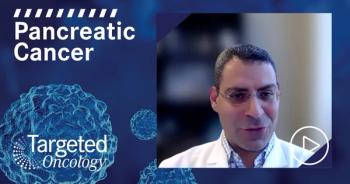
HCC Survival Impacted by Radiofrequency Ablation Dwell Time
A more than 25-month improvement in overall survival was seen with lyso-thermosensitive liposomal doxorubicin (LTLD; ThermoDox) combined with optimized (?45 minutes dwell time) radiofrequency ablation in patients with hepatocellular carcinoma.
Riccardo Lencioni, MD
A more than 25-month improvement in overall survival (OS) was seen with lyso-thermosensitive liposomal doxorubicin (LTLD; ThermoDox) combined with optimized (≥45 minutes dwell time) radiofrequency ablation (RFA) in patients with hepatocellular carcinoma (HCC), according to a presentation by Riccardo Lencioni, MD, at the 2015 International Liver Cancer Association (ILCA) Annual Conference.1
"With median overall survival of more than 6.5 years, or 79 months, data from the HEAT study post-hoc analysis suggest a greater than 2-year median survival advantage for treatment with ThermoDox plus optimized RFA, a meaningful finding given that few treatments are effective in prolonging survival in HCC," said Lencioni professor and director of Diagnostic Imaging and Intervention at Pisa University School of Medicine in Pisa, Italy, said in a statement.
In the phase III HEAT study, 285 patients were treated with RFA for ≥45 minutes in combination with LTLD. In this group, treatment with the combination provided an average 58% improvement in OS. The median OS with LTLD plus RFA was 79 months compared with 53.57 months with RFA alone (HR, 0.63; 95% CI, 0.43-0.93;P= .0198).
In the phase III HEAT study, 701 untreated patients with HCC were randomized to receive LTLD plus RFA or RFA alone. For the primary endpoint of progression-free survival (PFS), there was not a statistically significant difference between the two arms (HR, 0.96; 95% CI, 0.78-1.17). Additionally, the secondary endpoint of overall survival (OS) was not improved with the addition of LTLD (HR, 0.95; 95% CI, 0.71-1.27).
However, a closer analysis of the HEAT protocol paired with prior findings found that the lack of guidance on the duration of RFA may have attributed to the lack of OS and PFS benefit.
In a subgroup analysis of those who received RFA for <45 minutes (n = 166), patients who received LTLD had a 37% worse OS versus RFA alone (HR, 1.34). In a group of patients treated with RFA for 45 to 90 minutes (n = 181), there was a 40% improvement in OS with LTLD (HR, 0.60).
"Results from the HEAT study, one of the largest clinical trials ever conducted in primary liver cancer, reinforce the potential for ThermoDox in combination with an optimized RFA regimen as a curative treatment for this deadly cancer," Lencioni said.
In another presentation at ILCA, Ghassan K. Abou-Alfa, MD, from Memorial Sloan Kettering Cancer, presented findings on the importance of adequate RFA duration, with or without LTLD.2This study emphasized the importance of adequate heating, regardless of whether other therapies were used.
For patients with an HCC lesion size of 3 cm to 5 cm, the median OS for those who received RFA alone for <45 minutes was 57.9 months. When RFA was used alone for ≥45 minutes, the median OS increased to 63 months. In those treated with RFA plus LTLD for <45 minutes the median OS was 55 months, which increased to 79 months when treatment was administered for ≥45 minutes.
In those with lesions 5 cm to 7 cm, similar findings were observed. In those who received RFA plus LTLD for ≥45 minutes, the median OS was not evaluable. In those treated with less than 45 minutes of RFA and LTLD, median OS was 25.3 months, which was significantly less than what was seen with RFA alone in the <45 and ≥45 minute groups (31.3 and 45.5 months, respectively).
"The continuing strength of the HEAT study data reinforces our confidence in ThermoDox as the first and only frontline therapy for newly diagnosed HCC patients and further improves the risk profile of our phase III OPTIMA study, currently enrolling patients in 12 countries globally," Michael H. Tardugno, chairman, president and chief executive officer at Celsion, the company developing LTLD, said in a statement.
Based on these data, the phase III OPTIMA study was launched in the first half of 2014, following clearance from the FDA. The study plans to enroll 550 patients with primary HCC. Patients will receive LTLD at 50 mg/m2with RFA for >45 minutes. OS is the primary endpoint of the study (NCT02112656).
References
- Lencioni R. OPTIMA Phase III Clinical Trial: Study Design and Protocols. Presented at: International Liver Cancer Association 9th Annual Conference; September 4-6; Paris, France.
- Abou-Alfa GK. Thermodox in HCC: Development Plan and Lessons Learned. Presented at: International Liver Cancer Association 9th Annual Conference; September 4-6; Paris, France.









































